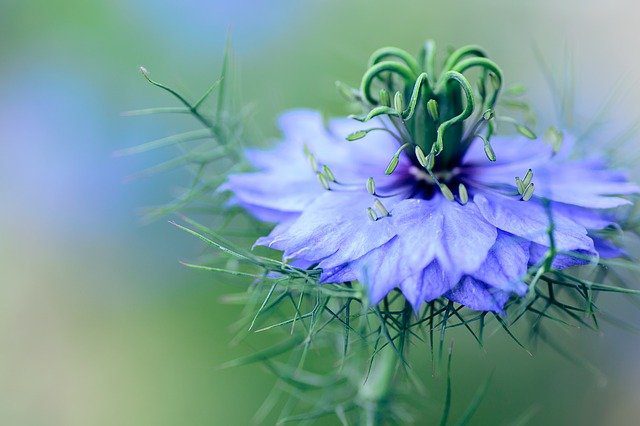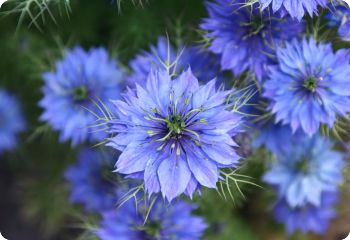
Last updated on May 21st, 2023 at 06:38 pm
Love-in-a-mist, also known as the nigella or devil in the bush, is a flower of the Ranunculaceae family. It blooms annually.
Etymologically, this flower is known to botanists as Nigella Damascena. Herein, Damascena refers to the Syrian capital Damascus. The flower is native to three continents, i.e., Europe, Africa & Asia. Specifically, it’s a prevalent flower in Southern Parts of Europe, South West Asia & North Africa. Recently, this species has also spread to North Europe. The meaning of love-in-a-mist flower is different across the globe.
Nonetheless, the love-in-a-mist flower has one common root for its name. The name love-in-a-mist is a reference to the distinct design of the flower. The flower is nestled within a multifid ring with lacy bracts. This ring holds the flower in a lover’s grip.
It can grow to lengths that range from 8 inches (ca. 20 cm) to over 20 inches (ca. 51 cm). The love-in-a-mist flower has thread-like alternate leaves that further accentuate the flower.
It usually blooms at the beginning of summer. The flower may have 5 to 25 petals & it can grow in blue, white, pale purple, or pink colors.
Unlike other buttercup flowers, this flower bears an inflated fruit with multiple integrated follicles. It tends to grow in the same spots for many years.
What does the Love-in-a-Mist (Nigella) flower symbolize?

Love-in-a-mist (nigella) is an ornamental flower that needs very delicate care. This flower is symbolic of different things across cultures, but some interpretations & uses have become very common. More so with the advent of social media & commercial practices. Today, some forms of love-in-a-mist flower meaning prevail over the rest.
It has wide use in the flowers dedicated to St. Catherine month before Christmas, i.e., 25th November. This is the day when the Saint became a martyr while being tortured on a spiked wheel. The flower is symbolic of that wheel & its foliage is a reminder of the Saint’s sacrifice.
North Africa carries some Renaissance tradition where the deception of its spiky seeds has earned this flower the name Devil in the Bush. A beautiful looking flower that attracts people but hides dangerous spikes, like an enticing devil.
Another less-used name is Bride in hair, i.e., a Bride who married while letting her hair down to signify virginity. This archaic interpretation continues to this day in South East Asia.
All in all, the love-in-a-mist (nigella) flower symbolic meanings are:
- harmony
- love
Meaning of the Love-in-a-Mist (Nigella) flower colors
White color

The white flowers are often used in folk traditions & magic as an ode to the purity of love. Legends associate it with the divine love of St. Katherine to the transformative love of fairies. While all love-in-a-mist (nigella) flowers are Katherine flowers, to the common folk, the white flower is known by this name.
During the Middle Ages, alchemists preferred this flower as an ingredient for their elixirs. This flower was also associated with the virginity of new brides. No wonder the meaning of love-in-a-mist flower meaning expanded across many folklores.
White is a positive color and represents purity. Miss Jekyll Alba is a white nigella flower with pretty green seed pods. It suits the cottage garden where you can make beautiful cut flowers and foliage for any vase.
Pink color

This flower color is associated with the deceptive love of magic. Like the white flower signifies good magic, pink can be potent for bad magic.
It is often associated with the magical charm of the green nymph at the river Goksu in Turkey. She captivated the leader of the crusaders, Holy Emperor Frederick 1. The king got so infatuated with the spirit that he drowned in the river on a foggy day. After that, these flowers grew on the banks from the hair of the nymph. Legend has it that the nymph and the king were never seen again.
Perhaps the meaning of love-in-a-mist (nigella) flower was about eternal love & not deception.
Nigella Mulberry rose is a beautiful pink flower with plumy foliage that grows in just 8 weeks. It is easy to cultivate and a great addition to dried floral arrangements.
Blue color

The blue rendition of this flower is associated with long-lasting love. It is about the peace associated with love. This is not a turbulent love but a love that grants stability and helps in creation.
This flower is often used in bouquets that symbolize peace. While modern wreaths at funerals have white flowers, the blue love-in-a-mist (nigella) flower may also be included for loving peace.
The blue color of this flower also represents freedom and inspiration. It is very traditional and conservative. “Miss Jekyll Blue” blooms in June with attractive sky-blue flowers. It is the most valued self-seeder. It is a great filler in the garden and reseeds profusely. This flower is a good companion plant for Asian roses and lilies.
The nigella flower, Oxford blue, is very beautiful and appealing. It is a classic nigella flower. Heaps of feathery foliage with dreamy blue flowers are so attractive. It is great for a country-style garden. It usually germinates in 10-15 days.
Pale purple color

Purple is often associated with royalty & love-in-a-mist (nigella) flower is associated with virginity. Naturally, these interpretations represent the new bloodline among the royal and the wealthy.
This flower is also symbolic of the nature of the newborn, how it can be a savior or a destroyer. The possibility of being a healer or a poison, like a flower.
The pale nature of this flower also represents duality in the royal bloodline, how it can be in favor of the earthly power or the divine power that requires love and sacrifice.
Interesting facts about the Love-in-a-Mist (Nigella) flowers
- The root word for the love-in-a-mist (nigella) flower’s biological name is “Niger,” or black. Ironically, this flower does not grow in black. Instead, it is commonly seen in the following colors, each of which has a different significance.
- The black may refer to its black seeds that are midway between medicine & poison.
- In the Hadith, they are quoted as seeds that can cure everything except death.
- You may also interpret the love-in-a-mist flower as meaning to be of medicinal significance.
- Nigella is very well-known as a medicinal plant around the world. It has antioxidant, antiparasitic, antifungal, antibacterial, and anti-inflammatory features.
- Nigella treats many medical conditions and diseases like digestive troubles, blood disorders, respiratory conditions, skin problems, and nervous system disorders.
- It can destroy cancer cells and strengthen the good cells to fight against cancer.
- Nigella seeds are used in cooking. They are used in baked foods, pickles, and dried foods.
- It is a good substitute for pepper. The seeds are aromatic and smell like pepper.
How to grow Love-in-a-Mist (Nigella) flowers
Love-in-a-mist (nigella) is a lovely cottage garden plant that works well as a filler. The airy foliage complements plants with larger leaves.
- Plant the love-in-a-mist (nigella) in fertile, nutrient-rich soil.
- Place it in direct sunlight.
- Water it slowly but thoroughly until the top two inches of soil are soaked.
- Apply a general-purpose fertilizer to the soil.
How to care for Love-in-a-Mist (Nigella) flowers
- Maintain moist soil.
- Germination takes between two and three weeks.
- It should be fertilized once a month.
- To encourage more flowering, deadhead the flowers.
Best time to gift Love-in-a-Mist (Nigella) flowers
The time is a culmination of symbolism and the season of the year. The love-in-a-mist (nigella) flower is associated with seasonal behaviors. Since summer is a time of intense changes in life, it is a time to wish people love, luck & tranquility. It is also the time when this flower grows in abundance.
This is why the love-in-a-mist flower is an ideal gift for summer, especially for those who wish to start fresh and embark on a journey of passion.
It may inspire passionate conduct throughout the day if gifted in the morning. Although flowers are grown throughout the year, gifting season-appropriate flowers can benefit those who garden. A recipient may want to grow the love-in-a-mist flowers & the right season can ensure better plant growth. Nonetheless, there is no hard and fast rule for gifting.
These flowers are very popular and can be dried for winter decoration. The burgundy and green seed pods are used for dried or fresh floral arrangements. If leaves of the lower part of the stem are taken, the flowers will last longer. The charming flowers and their ornamental seed pods make lovely bouquets.
Since bouquets are made with both fresh and dried forms, they can be gifted anytime throughout the year.
Conclusion
The underlying theme of love-in-a-mist (nigella) flower is love and devotion. While certain variants may be associated with deception, they are transformative. Their outcomes are not exactly negative for those seeking love.
If you want to know and learn more about flowers, we at PansyMaiden can help you. Check out our fun, easy-to-read, and informative flower-related content that you will surely enjoy!
